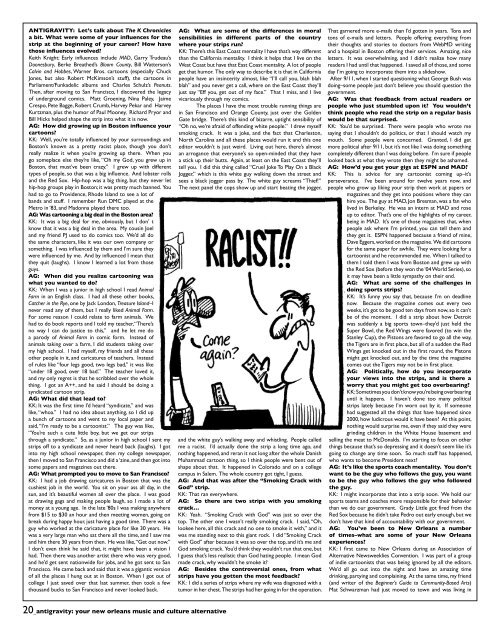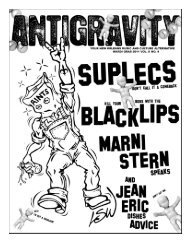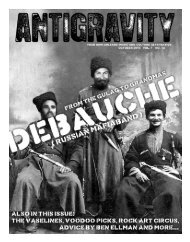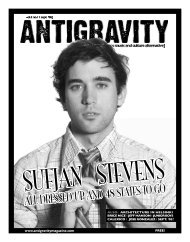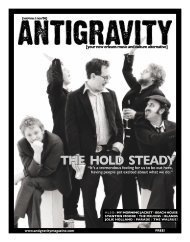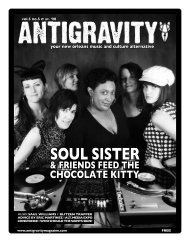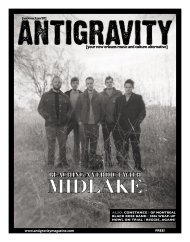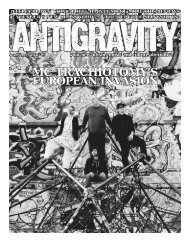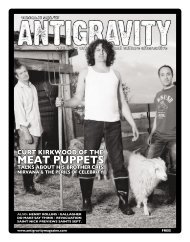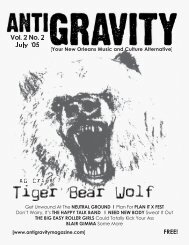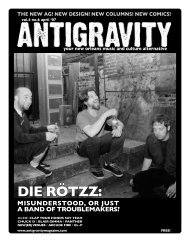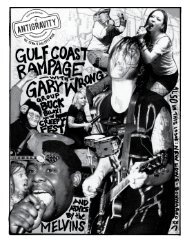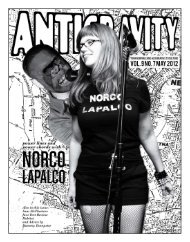June 2006 (PDF) - Antigravity Magazine
June 2006 (PDF) - Antigravity Magazine
June 2006 (PDF) - Antigravity Magazine
- No tags were found...
Create successful ePaper yourself
Turn your PDF publications into a flip-book with our unique Google optimized e-Paper software.
ANTIGRAVITY: Let’s talk about The K Chroniclesa bit. What were some of your influences for thestrip at the beginning of your career? How havethose influences evolved?Keith Knight: Early influences include MAD, Garry Trudeau’sDoonesbury, Berke Breathed’s Bloom County, Bill Watterson’sCalvin and Hobbes, Warner Bros. cartoons (especially ChuckJones, but also Robert McKimson’s stuff), the cartoons inParliament/Funkadelic albums and Charles Schulz’s Peanuts.Then, after moving to San Francisco, I discovered the legacyof underground comics. Matt Groening, Nina Paley, JaimeCrespo, Pete Bagge, Robert Crumb, Harvey Pekar and HarveyKurtzman, plus the humor of Paul Mooney, Richard Pryor andBill Hicks helped shape the strip into what it is now.AG: How did growing up in Boston influence yourcartoons?KK: Well, you’re totally influenced by your surroundings andBoston’s known as a pretty racist place, though you don’treally realize it when you’re growing up there. When yougo someplace else they’re like, “Oh my God, you grew up inBoston, that must’ve been crazy.” I grew up with differenttypes of people, so that was a big influence. And lobster rollsand the Red Sox. Hip-hop was a big thing, but they never lethip-hop groups play in Boston; it was pretty much banned. Youhad to go to Providence, Rhode Island to see a lot ofbands and stuff. I remember Run DMC played at theMetro in ‘83, and Madonna played there too.AG: Was cartooning a big deal in the Boston area?KK: It was a big deal for me, obviously, but I don’ tknow that it was a big deal in the area. My cousin Joeland my friend PJ used to do comics too. We’d all dothe same characters, like it was our own company orsomething. I was influenced by them and I’m sure theywere influenced by me. And by influenced I mean thatthey quit (laughs). I know I learned a lot from thoseguys.AG: When did you realize cartooning waswhat you wanted to do?KK: When I was a junior in high school I read AnimalFarm in an English class. I had all these other books,Catcher in the Rye, one by Jack London, Treasure Island–Inever read any of them, but I really liked Animal Farm.For some reason I could relate to farm animals. Wehad to do book reports and I told my teacher, “There’sno way I can do justice to this,” and he let me doa parody of Animal Farm in comic form. Instead ofanimals taking over a farm, I did students taking overmy high school. I had myself, my friends and all theseother people in it, and caricatures of teachers. Insteadof rules like “four legs good, two legs bad,” it was like“under 18 good, over 18 bad.” The teacher loved it,and my only regret is that he scribbled over the wholething. I got an A++, and he said I should be doing asyndicated cartoon strip.AG: What did that lead to?KK: It was the first time I’d heard “syndicate,” and waslike, “whoa.” I had no idea about anything, so I did upa bunch of cartoons and went to my local paper andsaid, “I’m ready to be a cartoonist.” The guy was like,“You’re such a cute little boy, but we get our stripsthrough a syndicate.” So, as a junior in high school I sent mystrips off to a syndicate and never heard back (laughs). I gotinto my high school newspaper, then my college newspaper,then I moved to San Francisco and did a ‘zine, and then got intosome papers and magazines out there.AG: What prompted you to move to San Francisco?KK: I had a job drawing caricatures in Boston that was thecushiest job in the world. You sit on your ass all day, in thesun, and it’s beautiful women all over the place. I was goodat drawing gags and making people laugh, so I made a lot ofmoney at a young age. In the late ‘80s I was making anywherefrom $15 to $30 an hour and then meeting women, going onbreak during happy hour, just having a good time. There was aguy who worked at the caricature place for like 30 years. Hewas a very large man who sat there all the time, and I saw meand him there 30 years from then. He was like, “Get out now.”I don’t even think he said that, it might have been a vision Ihad. Then there was another artist there who was very good,and he’d get sent nationwide for jobs, and he got sent to SanFrancisco. He came back and said that it was a gigantic versionof all the places I hung out at in Boston. When I got out ofcollege I just saved over that last summer, then took a fewthousand bucks to San Francisco and never looked back.AG: What are some of the differences in moralsensibilities in different parts of the countrywhere your strips run?KK: There’s this East Coast mentality I have that’s way differentthan the California mentality. I think it helps that I live on theWest Coast but have that East Coast mentality. A lot of peopleget that humor. The only way to describe it is that in Californiapeople have an insincerity almost, like “I’ll call you, blah blahblah” and you never get a call, where on the East Coast they’lljust say “Eff you, get out of my face.” That I miss, and I livevicariously through my comics.The places I have the most trouble running things arein San Francisco and Orange County, just over the GoldenGate bridge. There’s this kind of bizarre, uptight sensibility of“Oh no, we’re afraid of offending white people.” I drew myselfsmoking crack. It was a joke, and the fact that Charleston,North Carolina and all these places would run it and this oneeditor wouldn’t is just weird. Living out here, there’s almostan arrogance that everyone’s so open-minded that they havea stick up their butts. Again, at least on the East Coast they’lltell you. I did this thing called “Cruel Joke To Play On a BlackJogger,” which is this white guy walking down the street andsees a black jogger pass by. The white guy screams “Thief!”The next panel the cops show up and start beating the jogger,and the white guy’s walking away and whistling. People calledme a racist. I’d actually done the strip a long time ago, andnothing happened, and reran it not long after the whole DanishMuhammad cartoon thing, so I think people were bent out ofshape about that. It happened in Colorado and on a collegecampus in Salem. The whole country got tight, I guess.AG: And that was after the “Smoking Crack withGod” strip.KK: That ran everywhere.AG: So there are two strips with you smokingcrack…KK: Yeah. “Smoking Crack with God” was just so over thetop. The other one I wasn’t really smoking crack. I said, “Oh,lookee here, all this crack and no one to smoke it with,” and itwas me standing next to this giant rock. I did “Smoking Crackwith God” after because it was so over the top, and it’s me andGod smoking crack. You’d think they wouldn’t run that one, butI guess that’s less realistic than God hating people. I mean Godmade crack, why wouldn’t he smoke it?AG: Besides the controversial ones, from whatstrips have you gotten the most feedback?KK: I did a series of strips where my wife was diagnosed with atumor in her chest. The strips had her going in for the operation.That garnered more e-mails than I’d gotten in years. Tons andtons of e-mails and letters. People offering everything fromtheir thoughts and stories to doctors from WebMD writingand a hospital in Boston offering their services. Amazing, niceletters. It was overwhelming, and I didn’t realize how manyreaders I had until that happened. I saved all of those, and someday I’m going to incorporate them into a slideshow.After 9/11, when I started questioning what George Bush wasdoing–some people just don’t believe you should question thegovernment.AG: Was that feedback from actual readers orpeople who just stumbled upon it? You wouldn’tthink people who read the strip on a regular basiswould be that surprised.KK: You’d be surprised. There were people who wrote mesaying that I shouldn’t do politics, or that I should watch mymouth. Some people were concerned. Granted, I did getmore political after 9/11, but it’s not like I was doing somethingcompletely different than I was doing before. I’m sure if peoplelooked back at what they wrote then they might be ashamed.AG: How’d you get your gigs at ESPN and MAD?KK: This is advice for any cartoonist coming up–it’sperseverance. I’ve been around for twelve years now, andpeople who grow up liking your strip then work at papers ormagazines and they get into positions where they canhire you. The guy at MAD, Jon Bresman, was a fan wholived in Berkeley. He was an intern at MAD and roseup to editor. That’s one of the highlights of my career,being in MAD. It’s one of those magazines that, whenpeople ask where I’m printed, you can tell them andthey get it. ESPN happened because a friend of mine,Dave Eggers, worked on the magazine. We did cartoonsfor the same paper for awhile. They were looking for acartoonist and he recommended me. When I talked tothem I told them I was from Boston and grew up withthe Red Sox (before they won the ‘04 World Series), soit may have been a little sympathy on their end.AG: What are some of the challenges indoing sports strips?KK: It’s funny you say that, because I’m on deadlinenow. Because the magazine comes out every twoweeks, it’s got to be good ten days from now, so it can’tbe of the moment. I did a strip about how Detroitwas suddenly a big sports town–they’d just held theSuper Bowl, the Red Wings were favored (to win theStanley Cup), the Pistons are favored to go all the way,the Tigers are in first place, but all of a sudden the RedWings get knocked out in the first round, the Pistonsmight get knocked out, and by the time the magazinecomes out the Tigers may not be in first place.AG: Politically, how do you incorporateyour views into the strips, and is there aworry that you might get too overbearing?KK: Sometimes you don’t know you’re being overbearinguntil it happens. I haven’t done too many politicalstrips lately because I’m worn out by it. If someonehad suggested all the things that have happened since2000, how ludicrous would it have been? At this point,nothing would surprise me, even if they said they weregrinding children in the White House basement andselling the meat to McDonalds. I’m starting to focus on otherthings because that’s so depressing and it doesn’t seem like it’sgoing to change any time soon. So much stuff has happened,who wants to become President next?AG: It’s like the sports coach mentality. You don’twant to be the guy who follows the guy, you wantto be the guy who follows the guy who followedthe guy.KK: I might incorporate that into a strip soon. We hold oursports teams and coaches more responsible for their behaviorthan we do our government. Grady Little got fired from theRed Sox because he didn’t take Pedro out early enough, but wedon’t have that kind of accountability with our government.AG: You’ve been to New Orleans a numberof times–what are some of your New Orleansexperiences?KK: I first came to New Orleans during an Association ofAlternative Newsweeklies Convention. I was part of a groupof indie cartoonists that was being ignored by all the editors.We’d all go out into the night and have an amazing timedrinking, partying and complaining. At the same time, my friend(and writer of the Beginner’s Guide to Community-Based Arts)Mat Schwarzman had just moved to town and was living in20_antigravity: your new orleans music and culture alternative


